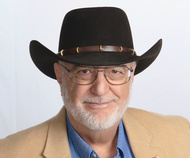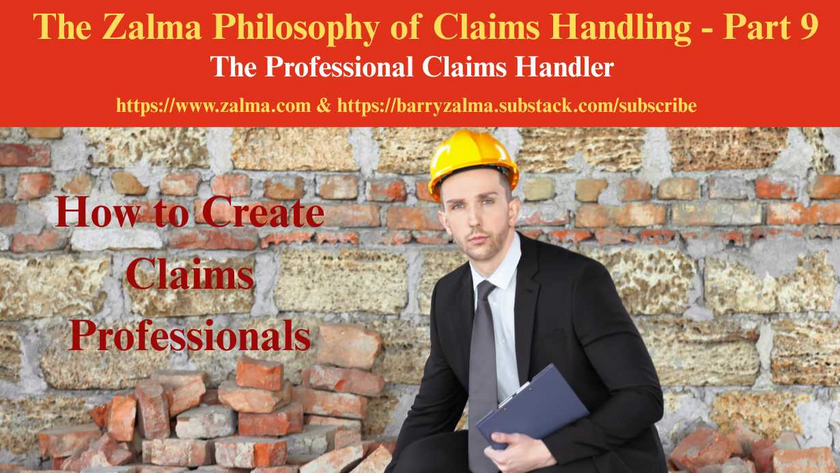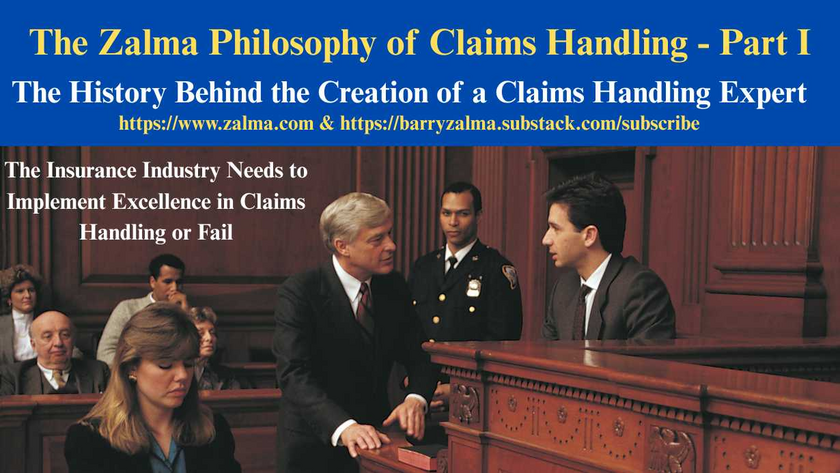
HOW THE LAW OF UNINTENDED CONSEQUENCES COSTS THE INSURANCE INDUSTRY
Read the full article at https://lnkd.in/gUytarJD and at https://zalma.com/blog plus more then 4200 posts and see the full video at https://lnkd.in/gMqmUSBS and at https://lnkd.in/ggQFFB-v.
Neither the courts nor the governmental agencies seem to be aware that in a modern, capitalistic society, insurance is a necessity. No prudent person would take the risk of starting a business, buying a home, or driving a car without insurance. The risk of losing everything would be too great. By using insurance to spread the risk, taking the risk to start a business, buy a home, or drive a car becomes possible.
Insurance has existed since a group of Sumerian farmers, more than 5,000 years ago, scratched an agreement on a clay tablet that if one of their number lost his crop to storms, the others would pay part of their earnings to the one damaged. Over the eons, insurance has become more sophisticated, but the deal is essentially the same. An insurer, whether an individual or a corporate entity, takes contributions (premiums) from many and holds the money to pay those few who lose their property from some calamity, like fire. The agreement, a written contract to pay indemnity to another in case a certain problem, calamity, or damage that is fortuitous, that is that occurs by accident, is called insurance.
In a modern industrial society, almost everyone is involved in or with the business of insurance. They insure against the risk of becoming ill, losing a car in an accident, losing business due to fire, becoming disabled, losing their life, losing a home due to flood or earthquake, or being sued for accidentally causing injury to another. The insurers, insureds, or people damaged by those insured are dependent on one another.
In a country where human interactions are governed solely by the terms of written contracts, insurance would be a simple means of spreading risk and providing indemnity based on the promises made by the contract of insurance. But, in this the real world, insurance contracts are controlled by statutes enacted to ostensibly protect the consumer of insurance, regulations imposing obligations on the conduct of insurers and the decisions of trial and appellate courts interpreting insurance contracts.
A simple insurance contract between two parties might say: “I insure you against the risk of loss of your engagement ring valued at $15,000 by all risks of direct physical loss except wear and tear for a premium paid by you of $15.00.” Anyone who could read would understand that contract. If something happens to damage, destroy or lose the ring the insurer will pay you $15,000.00. However, insurers cannot write such a simple contract because the state requires many terms and conditions that complicate the policy wording and confuse the common person. The states and courts that did so had nothing but good intentions to protect the consumer against the insurer and control the actions of the insurer.
EXAMPLES OF UNINTENDED CONSEQUENCES & INSURANCE
Simplified Wording Causes Ambiguity
Insurance contracts can be simple or exceedingly complex, depending on the risks taken on by the insurer. Regardless, insurance is neither more nor less than a contract whose terms are agreed to by the parties to the contract. Over the last few centuries, almost every word and phrase used in insurance contracts have been interpreted and applied by one court or another. Ambiguity in contract language became certain. However, the average person saw the insurance contract as incomprehensible and impossible to understand.
Courts, struggling to understand policies of insurance added to the concern of Legislators:
As said in Insurance Company of North America v. Electronic
Purification Company, 67 Cal. 2d 679, 689, 63 Cal. Rptr. 382, 433 (1967), the insurance company gave the insured coverage in relatively simple language easily understood by the common man in the marketplace, but attempted to take away a portion of this same coverage in paragraphs and language which even a lawyer, be he from Philadelphia or Bungy, would find difficult to comprehend. [Hays v. Pacific Indemnity Group,8 Cal. App. 3d. 158, 80 Cal. Rptr. 815 (1970).]
Ostensibly to protect the public, to salve the concerns of jurists like the one quoted above, insurance regulators and Legislatures decided to require that insurers write their policies in “easy to read” language. Because they were required to do so by law, the insurers changed the words in their contracts into language that people with a fourth-grade education could understand. Precise language interpreted by hundreds of years of court decisions was disposed of and replaced with imprecise, easy to read language. For examples of the “easy to read” or “plain English statutes” go to Appendix 1.
The law of unintended consequences came into play. Instead of protecting the consumer, the imprecise language resulted in thousands of lawsuits determined to impose penalties on insurers for attempting to enforce ambiguous “easy to read” language. The lawsuits cost insurers and their insureds millions of dollars to get court opinions that interpret the language and reword their “easy to read” policies to comply with the court decisions. For more than 30 years, the law of unintended consequences struck the insurance industry that found that a law designed to avoid litigation resulted in exactly the opposite.
The attempts by the regulators and courts to control insurers and protect consumers were made with the best of intentions. The judges and regulators found it necessary to protect the innocent against what they perceived to be rich and powerful insurers. Unfortunately, the plain English statutes had the opposite effect. But, of course, even after it became clear that easy to read policies cause more problems than they cure, the laws and regulations have not been changed.
Bad Faith Causes Bad Behavior
In the 1950s, the California Supreme Court created a tort new to the pantheon of U.S. jurisprudence: the tort of bad faith.
A tort is a civil wrong from which one person can receive damages from another for multiple injuries to person or property. The tort of bad faith was created because an insurer failed to treat an insured fairly, and the court felt that the traditional contract damages were insufficient to properly compensate the insured. The court allowed the insured to receive, in addition to the contract damages that the insured was entitled to receive under the contract had the insurer treated the insured fairly, damages for emotional distress and punitive damages to punish the insurer for its wrongful acts.
Insureds, lawyers for insureds, regulators, and courts across the United States cheered the action of the California Supreme Court, for providing a fair remedy to abused insureds. Most of the states emulated the California Supreme Court and adopted the tort created by the California Supreme Court either by statute or court decision.
The insurers who treated their insureds badly, in fact, profited since they continued their wrongful acts and only were required to pay the few insureds that sued. Those that did not sue added to the wrongdoing insurers profit margins. Honest insurers paid frauds and claims they did not owe and found they needed to raise premium charges to cover the extra expense. The increased premium paid by insureds to cover the extra expense were a clear example of the effect of the law of unintended consequences. The honest insurers who treated those they insured with good faith and fair dealing who paid off fraudsters and paid uncovered claims to avoid bad faith suits needed to charge more than the bad faith insurers who litigated with their insureds.
The law of unintended consequences struck the insurance industry and the insurance buying public. Rather than deter wrongful actions by application of the tort of bad faith, the law of unintended consequences resulted in punishing the honest and correct insurers, honoring the insurers who acted in bad faith with profit, and allowed many frauds to succeed.
Get my Book It’s Time to Abolish The Tort of Bad Faith
Available as a paperback here. Available as a Kindle book here.
(c) 2022 Barry Zalma & ClaimSchool, Inc.
Barry Zalma, Esq., CFE, now limits his practice to service as an insurance consultant specializing in insurance coverage, insurance claims handling, insurance bad faith and insurance fraud almost equally for insurers and policyholders. He practiced law in California for more than 44 years as an insurance coverage and claims handling lawyer and more than 54 years in the insurance business. He is available at http://www.zalma.com and [email protected].
Subscribe to Zalma on Insurance at locals.com https://zalmaoninsurance.local.com/subscribe.
Subscribe to Excellence in Claims Handling at https://barryzalma.substack.com/welcome.
Write to Mr. Zalma at [email protected]; http://www.zalma.com; http://zalma.com/blog; daily articles are published at https://zalma.substack.com.
Go to the podcast Zalma On Insurance at https://anchor.fm/barry-zalma; Follow Mr. Zalma on Twitter at https://twitter.com/bzalma; Go to Barry Zalma videos at Rumble.com at https://rumble.com/c/c-262921; Go to Barry Zalma on YouTube- https://www.youtube.com/channel/UCysiZklEtxZsSF9DfC0Expg; Go to the Insurance Claims Library – https://zalma.com/blog/insurance-claims-library/
Insurer’s Exclusion for Claims of Assault & Battery is Effective
Post 5250
Read the full article at https://lnkd.in/gBzt2vw9, see the video at https://lnkd.in/gEBBE-e6 and at https://lnkd.in/gk7EcVn9, and at https://zalma.com/blog plus more than 5250 posts.
Bar Fight With Security is an Excluded Assault & Battery
In The Cincinnati Specialty Underwriters Insurance Company v. Mainline Private Security, LLC, et al., Civil Action No. 24-3871, United States District Court, E.D. Pennsylvania (December 16, 2025) two violent attacks occurred in Philadelphia involving young men, Eric Pope (who died) and Rishabh Abhyankar (who suffered catastrophic injuries). Both incidents involved security guards provided by Mainline Private Security, LLC (“Mainline”) at local bars. The estates of the victims sued the attackers, the bars, and Mainline for negligence and assault/battery. The insurer exhausted a special limit and then denied defense or indemnity to Mainline Private Security.
INSURANCE COVERAGE
Mainline had purchased a commercial ...
Marine Insurer May Dispose of Vessel to Avoid Waste
Post 5249
Read the full article at https://lnkd.in/gfn_UHdp, see the video at https://lnkd.in/gDWVccnr and at https://lnkd.in/gv9nsBqk, and https://zalma.com/blog plus more than 5200 posts.
In Western World Insurance Company v. The Estate Of Shawn Arsenault, No. 25-cv-13413-PGL, United States District Court, D. Massachusetts (December 17, 2025) the USDC was asked to resolve a marine insurance dispute after the sinking of the F/V Seahorse, a commercial fishing vessel, off Cape Cod on June 8, 2025. The vessel’s owner and operator, Shawn Arsenault, died in the incident.
Western World Insurance Company issued a hull insurance policy for the vessel. With no personal representative yet appointed for the estate, the insurer cannot determine the proper payee for the insurance proceeds.
The insurer paid for the vessel’s recovery and removal, and the vessel is now with a salvage company, incurring substantial storage fees. The insurer determined the loss is covered under the ...
Marine Insurer May Dispose of Vessel to Avoid Waste
Post 5249
Read the full article at https://lnkd.in/gfn_UHdp, see the video at https://lnkd.in/gDWVccnr and at https://lnkd.in/gv9nsBqk, and https://zalma.com/blog plus more than 5200 posts.
In Western World Insurance Company v. The Estate Of Shawn Arsenault, No. 25-cv-13413-PGL, United States District Court, D. Massachusetts (December 17, 2025) the USDC was asked to resolve a marine insurance dispute after the sinking of the F/V Seahorse, a commercial fishing vessel, off Cape Cod on June 8, 2025. The vessel’s owner and operator, Shawn Arsenault, died in the incident.
Western World Insurance Company issued a hull insurance policy for the vessel. With no personal representative yet appointed for the estate, the insurer cannot determine the proper payee for the insurance proceeds.
The insurer paid for the vessel’s recovery and removal, and the vessel is now with a salvage company, incurring substantial storage fees. The insurer determined the loss is covered under the ...
Zalma’s Insurance Fraud Letter
Read the full article at https://lnkd.in/dG829BF6; see the video at https://lnkd.in/dyCggZMZ and at https://lnkd.in/d6a9QdDd.
ZIFL Volume 29, Issue 24
Subscribe to the e-mail Version of ZIFL, it’s Free! https://visitor.r20.constantcontact.com/manage/optin?v=001Gb86hroKqEYVdo-PWnMUkcitKvwMc3HNWiyrn6jw8ERzpnmgU_oNjTrm1U1YGZ7_ay4AZ7_mCLQBKsXokYWFyD_Xo_zMFYUMovVTCgTAs7liC1eR4LsDBrk2zBNDMBPp7Bq0VeAA-SNvk6xgrgl8dNR0BjCMTm_gE7bAycDEHwRXFAoyVjSABkXPPaG2Jb3SEvkeZXRXPDs%3D
Zalma’s Insurance Fraud Letter (ZIFL) continues its 29th year of publication dedicated to those involved in reducing the effect of insurance fraud. ZIFL is published 24 times a year by ClaimSchool and is written by Barry Zalma. It is provided FREE to anyone who visits the site at http://zalma.com/zalmas-insurance-fraud-letter-2/
Zalma’s Insurance Fraud Letter
Merry Christmas & Happy Hannukah
Read the following Articles from the December 15, 2025 issue:
Read the full 19 page issue of ZIFL at ...
The Professional Claims Handler
Post 5219
Posted on October 31, 2025 by Barry Zalma
An Insurance claims professionals should be a person who:
Can read and understand the insurance policies issued by the insurer.
Understands the promises made by the policy.
Understand their obligation, as an insurer’s claims staff, to fulfill the promises made.
Are competent investigators.
Have empathy and recognize the difference between empathy and sympathy.
Understand medicine relating to traumatic injuries and are sufficiently versed in tort law to deal with lawyers as equals.
Understand how to repair damage to real and personal property and the value of the repairs or the property.
Understand how to negotiate a fair and reasonable settlement with the insured that is fair and reasonable to both the insured and the insurer.
How to Create Claims Professionals
To avoid fraudulent claims, claims of breach of contract, bad faith, punitive damages, unresolved losses, and to make a profit, insurers ...

The History Behind the Creation of a Claims Handling Expert
The Insurance Industry Needs to Implement Excellence in Claims Handling or Fail
Post 5210
This is a change from my normal blog postings. It is my attempt. in more than one post, to explain the need for professional claims representatives who comply with the basic custom and practice of the insurance industry. This statement of my philosophy on claims handling starts with my history as a claims adjuster, insurance defense and coverage lawyer and insurance claims handling expert.
My Training to be an Insurance Claims Adjuster
When I was discharged from the US Army in 1967 I was hired as an insurance adjuster trainee by a professional and well respected insurance company. The insurer took a chance on me because I had been an Army Intelligence Investigator for my three years in the military and could use that training and experience to be a basis to become a professional insurance adjuster.
I was initially sat at a desk reading a text-book on insurance ...














